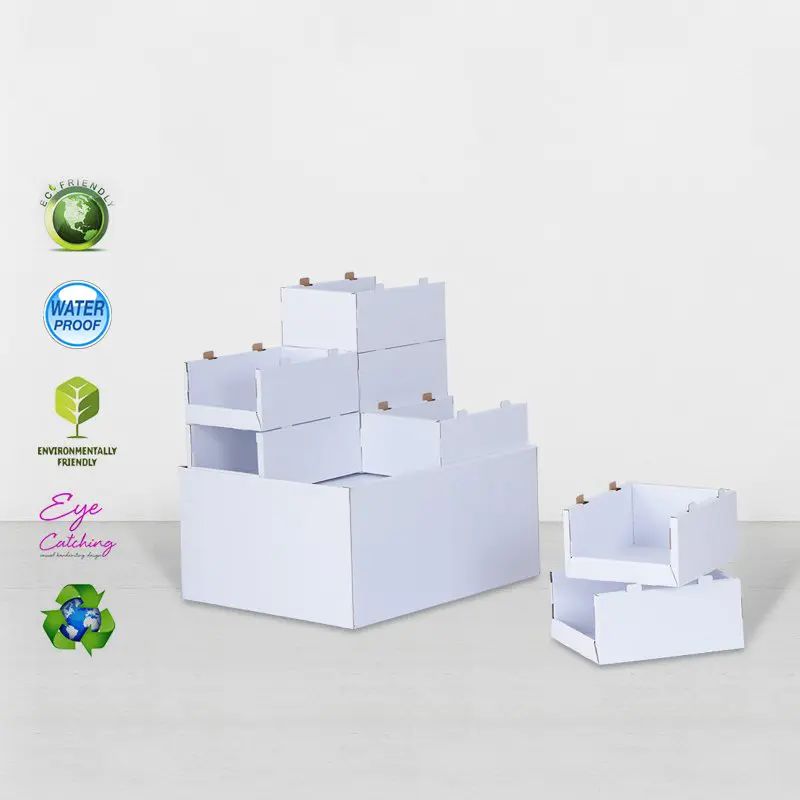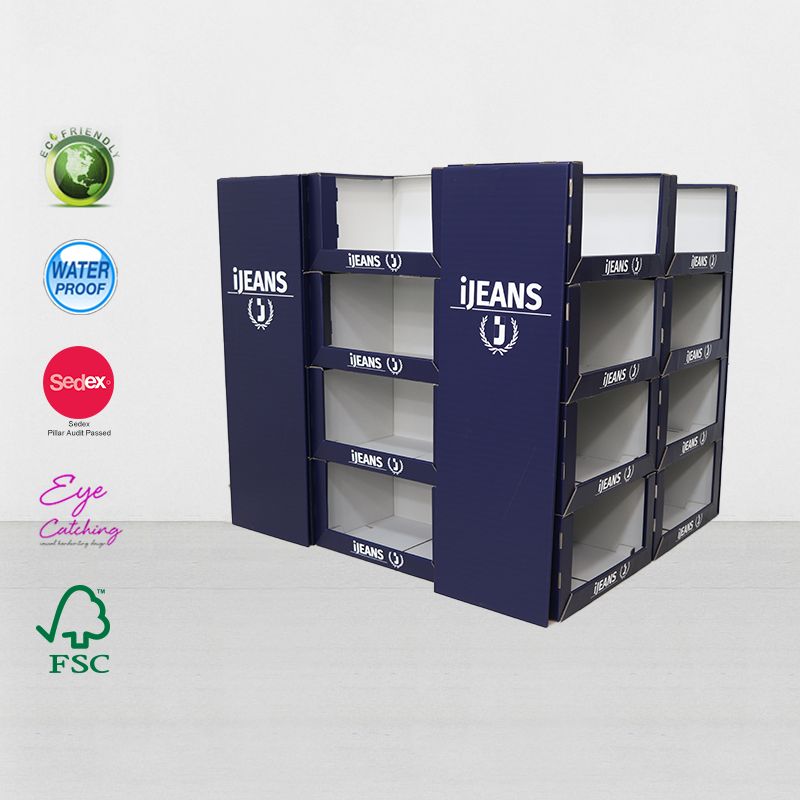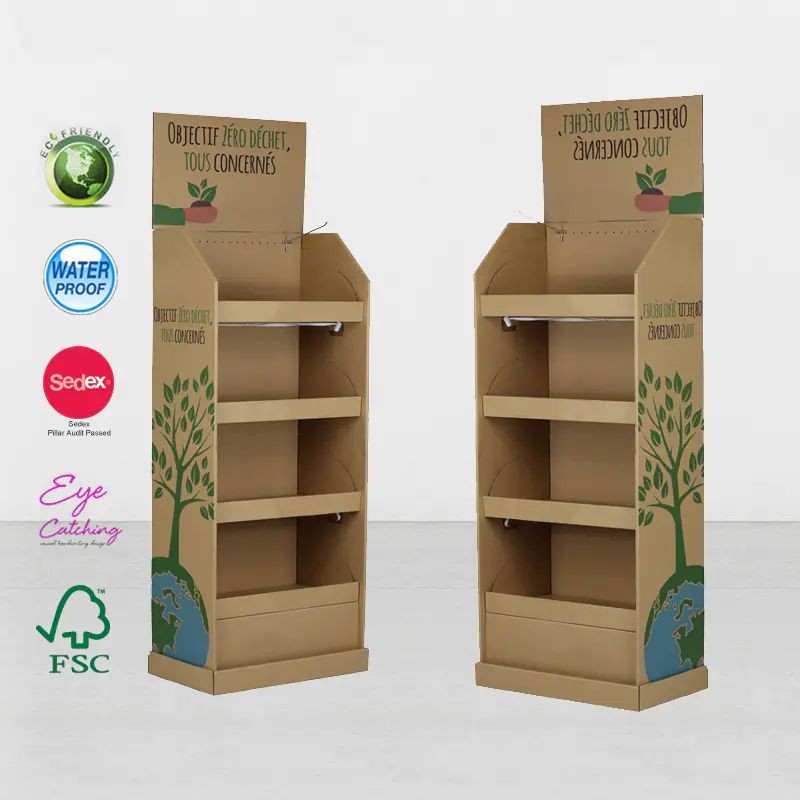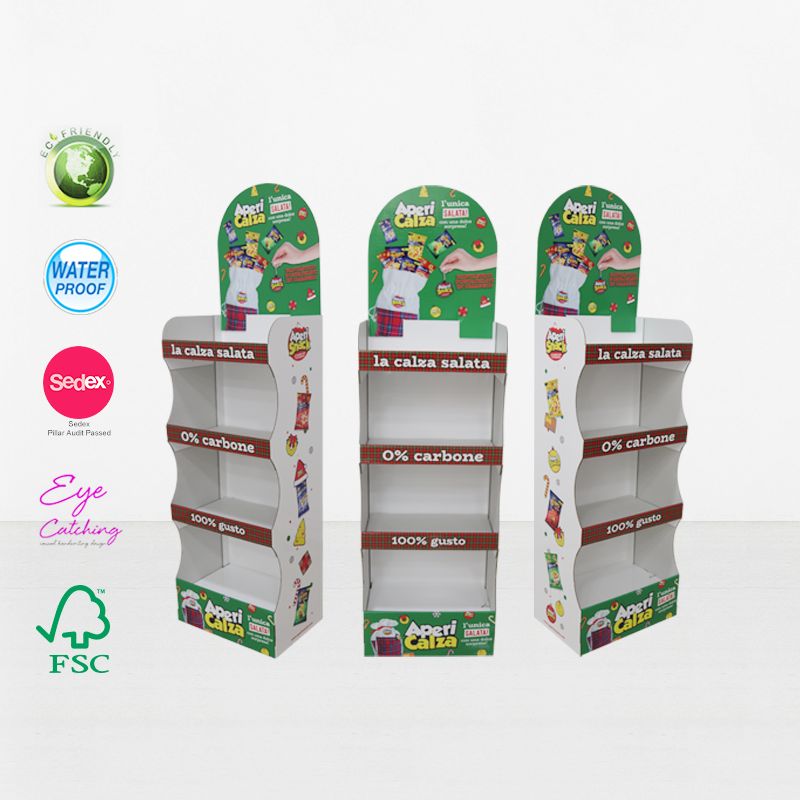Corrugated cardboard display racks have become widely used in retail display applications due to their environmental friendliness, lightweight design, and flexible customization. People generally believe that paper products are "thin and fragile," but corrugated cardboard is far from ordinary paper. Its unique structural design gives display racks considerable strength and load-bearing capacity.
So, just how strong are corrugated cardboard display racks? How much weight can they bear? This article will delve into this question from multiple perspectives, including structural principles, material parameters, process design, load-bearing range, and application scenarios, to fully address readers' questions about the strength of corrugated cardboard display racks.

Corrugated Cardboard Display Racks: Structure and Material Properties
1. Structural Principle of Corrugated Cardboard
Corrugated cardboard consists of face paper, core paper, lining paper, and a corrugated center. Its core lies in the flutes. The flute structure is similar to the arch of a bridge, and the wavy support distributes force, significantly improving overall compressive resistance.
• Fluting types: A-flute, B-flute, C-flute, E-flute, F-flute, etc. Different fluting types determine the thickness and strength of the cardboard.
• Composite structures: Single-wall, double-wall, and triple-wall. The more fluting layers, the greater the cardboard's pressure resistance.
2. Cardboard Types Used for Display Stands
Corrugated cardboard display stands often utilize high-strength corrugated cardboard. The face paper can be white cardboard or kraft paper, while the lining is primarily a sturdy core paper. Common combinations include:
• 250g-350g white cardboard + B/C flute core paper + 250g kraft paper
• Double-wall composite structure (BC flute or EB flute) improves overall load-bearing and pressure resistance.
3. Combining Strength with Environmental Protection
Unlike traditional wooden or metal display stands, corrugated cardboard display stands offer the advantages of lightweightness and recyclability while maintaining strength. These material properties have paved the way for their widespread use in supermarkets and stores.

Corrugated Cardboard Display Stand Strength
1. Compressive Strength
Corrugated cardboard's compressive strength stems from the arch bridge effect of its flute walls.
• Single-wall corrugated cardboard has an edge-to-edge compressive strength of 5-12 kN/m.
• Double-wall corrugated cardboard can reach 15-20 kN/m and is commonly used in display stand applications.
• High-strength triple-wall corrugated cardboard can even handle stacks of hundreds of kilograms of merchandise.
2. Flexural Strength
Display stands must remain upright without deformation, so the flexural stiffness of corrugated cardboard is crucial.
• Double-wall corrugated cardboard can have a longitudinal stiffness 2-3 times that of ordinary cardboard.
• Large corrugated cardboard display stands often utilize hems and slots to further enhance stability.
3. Tear and Abrasion Resistance
While corrugated cardboard display stands primarily emphasize load-bearing performance, they also require a certain degree of wear resistance due to frequent contact in the store. Lamination and varnishing processes can ensure strength while extending their lifespan.
Load Capacity of Corrugated Cardboard Display Stands
1. Single-Layer Load Capacity
Depending on the design and material, the load capacity of single-layer corrugated cardboard display stands ranges from:
• Standard single-layer: 2-5 kg/layer;
• Double-layer: 5-15 kg/layer;
• Reinforced cardboard floor display stands: Up to 20 kg/layer.
2. Overall Load Capacity
The load capacity of the entire stand depends on the number of layers, structure, and overall design:
• Standard cardboard display stands: Overall load capacity 30-50 kg;
• Double-layer corrugated floor display stands: Overall load capacity 80-120 kg;
• Reinforced pallet display stands: With a bottom pallet, the overall load capacity can exceed 200 kg.
3. Comparison of Load Capacity of Different Display Stand Types
• Cardboard floor display stands: With their layer arrangement, they are suitable for light to medium-weight merchandise.
• Cardboard pallet display stands: Based on pallets, they offer the highest load capacity and are suitable for heavyweight merchandise.
• Cardboard Hook Display Stands: A single hook can support tens to hundreds of grams, limiting overall load capacity but suitable for small-packaged goods.

Key Factors Affecting the Load-Bearing Capacity of Corrugated Cardboard Display Stands
1. Flute Type Selection
• A-Flute: Thick and cushioning, suitable for large, lightweight goods
• B-Flute: Thin and strong, suitable for small-packaged goods
• C-Flute: Between A-Flute and B-Flute, offering superior overall performance
• Double or triple flute: Significantly improves overall load-bearing capacity.
2. Paper Weight
• The weight of the face and back paper directly affects load-bearing capacity. High-weight kraft paper provides greater overall stability than low-weight core paper.
3. Structural Design
• Adding columns and reinforcing ribs can significantly increase overall load-bearing capacity.
• Slotted structures and dovetail joints can reduce cardboard slippage.
4. Processing
• Lamination and UV treatment enhance moisture and abrasion resistance.
• Hot and cold pressing processes can increase cardboard density and enhance strength.
Strength Requirements for Corrugated Cardboard Display Stands in Different Scenarios
1. Supermarket Promotions
Corrugated cardboard display stands are primarily used for food, beverages, cosmetics, and more. General Requirements:
• A load capacity of 5-10 kg per layer is sufficient.
• An overall load capacity of 30-60 kg is sufficient for daily display.
2. Hypermarkets and Warehouse Supermarkets
• In these locations, merchandise is large in quantity and heavy in weight.
• Pallet-based corrugated cardboard display stands can support 100-200 kg.
• Suitable for large-packaged beverages, detergents, and grain and oil products.
3. Convenience Stores and Small Retail Outlets
• Cardboard Hook Display Stands are more common.
• A single hook can support tens to hundreds of grams, making them suitable for small items such as candy, accessories, and stationery.
• The strength requirement is not the overall strength, but the sturdiness of the hooks.

Summary of the Strength Advantages of Corrugated Cardboard Display Stands
• Lightweight and High Strength: Although made of paper, the corrugated design allows for a high load-bearing capacity.
• Flexibility: The cardboard material, structure, and number of layers can be adjusted to meet specific needs, allowing for flexible control of load-bearing capacity.
• Cost-effectiveness: While maintaining strength, production and transportation costs are significantly lower than those of metal or wooden display stands.
• Sustainability: Combining strength with environmental friendliness, it meets both short- and medium-term retail display needs.
How strong are corrugated cardboard display stands?
A systematic analysis reveals that the strength of corrugated cardboard display stands far exceeds conventional wisdom. With proper design and manufacturing processes:
1. A single layer can support several to 20 kilograms;
2. The entire display can support tens to hundreds of kilograms;
3. When combined with a pallet design, it can even support over 200 kilograms.
Therefore, corrugated cardboard displays are not only strong enough to meet the display needs of most retail outlets, but also lightweight, environmentally friendly, and economical, making them a highly competitive display tool in supermarkets and stores.
Looking for low-price, high-quality cardboard displays for retail promotions?
Caiyijie Printing, founded in 2002 in Foshan, China, specializes in producing customized retail display solutions. Our main products include PDQ Boxes, Cardboard Floor Displays, Hook Displays, Dumpbins, Cutouts, Sidekick Displays, and Large Packaging Boxes.
We provide wholesale, bulk purchasing, and brand customization services, making us a trusted supplier for global retail companies seeking cost-effective, high-quality display solutions.

